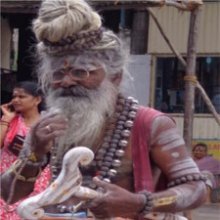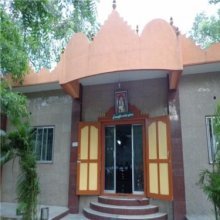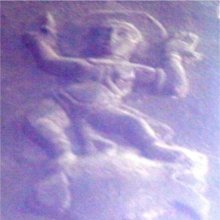Tiruvannamalai, Tiruvaṇṇāmalai, Thiruvannamalai: 2 definitions
Introduction:
Tiruvannamalai means something in the history of ancient India, Tamil. If you want to know the exact meaning, history, etymology or English translation of this term then check out the descriptions on this page. Add your comment or reference to a book if you want to contribute to this summary article.
Images (photo gallery)
(+10 more images available)
India history and geography
Source: DSpace at Pondicherry: Siddha Cult in Tamilnadu (historical)Tiruvaṇṇāmalai (12°13’N;79°4’E) is a well-known siddha-kśetra in Tamilnādu, which is also known for its impressive hill and a great spiritual attraction. The Lord enshrined in the great Temple at Tiruvaṇṇāmalai is known by the name of Aruṇācaleśvara with his consort Umā, here known as Apithakucha Nāyaki.
Source: What is India: Annual Report on Indian Epigraphy (1945-1952)Tiruvaṇṇāmalai is an archaeologically important site situated in Tiruvannamalai-taluk (Arcot district, Madras), known for inscriptions regarding the ancient history of India. For example, at Tiruvaṇṇāmalai there is a Tamil inscription on the rock in the guhai of Namaśśivāyar which records the date of the death of Namaśśivāyar. It is dated Śaka 1419.
Another inscription at the Aruṇācaleśvarasvāmin temple at Tiruvaṇṇāmalai registers the grant of the magamai on merchandise by Āyiravan Nagarattār headed by Pachchaiyappa Cheṭṭiyār of Maṇalūrpeṭṭai for the mid-day service of god Aruṇācaleśvara at Tiruvaṇṇāmalai and for charity at the maṭha. It is dated Śaka 1613.
Source: Shodhganga: Siddha Cult in TamilnaduTiruvannamalai refers to one of the various famous Siddha Centre distributed throughout South India and Tamil Nadu. The Siddha cult represents a Tantric philosophy that emerged from the combination of several elements found in traditions such as Shaivism (viz., Pashupata), Shaktism, Jainism, Tantric Buddhism (Vajrayana), etc. Both the Siddha and the Navanath cult (i.e., Nava-natha, ‘nine saints’) are popular in South India [viz., Tiruvannamalai] and Tamilnadu. A Siddha was an inspired seer belonging to the marginalized sections of society who dissolved their past karma and crushed the roots of future karma.

The history of India traces the identification of countries, villages, towns and other regions of India, as well as mythology, zoology, royal dynasties, rulers, tribes, local festivities and traditions and regional languages. Ancient India enjoyed religious freedom and encourages the path of Dharma, a concept common to Buddhism, Hinduism, and Jainism.
See also (Relevant definitions)
Partial matches: Tiru, Anna, Annamalai, Malai.
Full-text (+15): Arunacalam, Annamalai, Arunakiri, Arunagiri, Conakiri, Ampal, Parvati, Arunachalam, Arunacala, Arunacaleshvara, Arunai, Sonagiri, Sonachalam, Sonacala, Kalyāṇa-Sundareśvara, Parvatha Malai, Arunacaleshvar, Shiva, Teyulinkam, Madampakkam.
Relevant text
Search found 16 books and stories containing Tiruvannamalai, Tiruvaṇṇāmalai, Thiruvannamalai, Tiru-aṇṇā-malai, Tiru-anna-malai, Tiruaṇṇā-malai, Tiruanna-malai, Tiru-aṇṇāmalai, Tiru-annamalai; (plurals include: Tiruvannamalais, Tiruvaṇṇāmalais, Thiruvannamalais, malais, aṇṇāmalais, annamalais). You can also click to the full overview containing English textual excerpts. Below are direct links for the most relevant articles:
Early Chola Temples (by S. R. Balasubrahmanyam)
Temples in Arunachalesvarar (Tiru-Annamalaiyar) < [Chapter X - Historical Survey]
Temples in Tiruvannamalai < [Chapter X - Historical Survey]
Bhagavan Ramana and Vasishtha Ganapati Muni < [October - December 1976]
Bhagavan Ramana and Vasishtha Ganapati Muni < [July – September 1976]
Ramana Maharshi and his Sadhana of Silence < [January – March, 1986]
Temples of Munnur (Historical Study) (by R. Muthuraman)
Pallava period (Social and Cultural History) (by S. Krishnamurthy)
Appendix: List of Temples of Pallava Period
Architecture of the Mahendra style < [Chapter 2 - Origin of Sculptural Art—Its Development and Scheme]
Sources for Study < [Chapter 1 - Introduction]
Later Chola Temples (by S. R. Balasubrahmanyam)
Note 2b: Chola Feudatories, the Magadai Chiefs < [Chapter XI - Kulottunga III (a.d. 1178 to 1218)]
Temples in Chengam (Chengama or Sengaima) < [Chapter XII - Temples of Kulottunga III’s Time]
Temples in Kalahasti < [Chapter XII - Temples of Kulottunga III’s Time]
Kashyapa Shilpa-shastra (study) (by K. Vidyuta)
1. Conclusion (Prākāras) < [Chapter 6 - Conclusion]
3. Conclusion (Gopuras) < [Chapter 6 - Conclusion]





